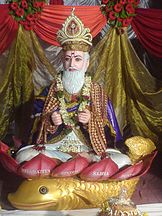Iṣṭa-devatā (Hinduism)

| Part of a series on |
| Hinduism |
|---|
 |
Ishta-deva or ishta devata (
It is especially significant to both the
Smarta worship
The "worship of the five forms" (
Worship forms

Typically a practitioner worships their Ishta-Deva through the form of a murti. This worship may involve offering items to their chosen divinity such as incense or flowers, reciting mantras, singing their names and offering prayers.
Remembering the deity and internally building a relationship with (or through) them is considered essential to the practise. Within the
Shaivites worship Shiva, either figuratively, or through his Lingam murti. As Shaivism contains both monistic and dualistic traditions either (or both) of the above approaches may be applicable.
See also
- Bhakti
- Bhakti Yoga
- Henotheism
- Henotheistic aspects of Hinduism
- Icon
- Kuldevta
- Patron saint
- Smartism
- Vedanta
- Yidam
References
- ^ V. S. Apte, A Practical Sanskrit Dictionary, p. 250.
- .
- ^ "Swaminarayan Satsang - Scriptures - Shikshapatri English - Shlok 47". Archived from the original on 17 March 2012. Retrieved 25 September 2011.
- ^ Grimes, John A. Ganapati: Song of the Self. (State University of New York Press: Albany, 1995) p. 162.
- ISBN 0-19-505742-2
External links
- The Significance of the Hindu Doctrine of Ishtadeva by Anantand Rambachan
